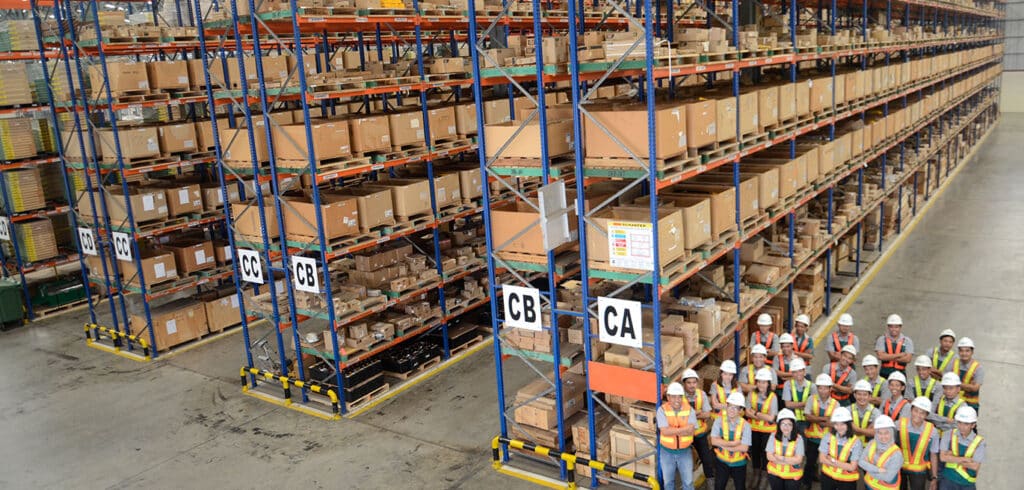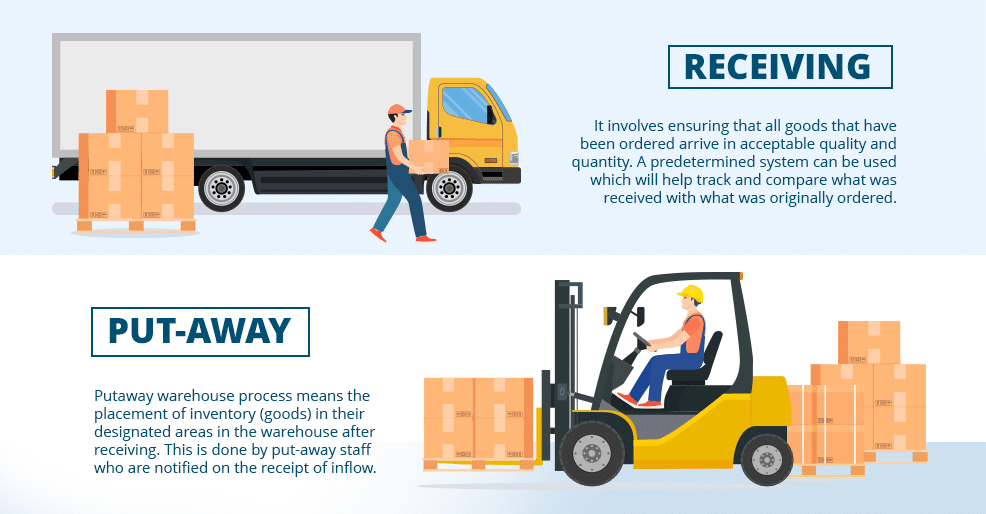In a bustling warehouse environment, the Warehouse Management System (WMS) stands as an indispensable ally. It’s not just about keeping track of where things are—it’s about orchestrating every piece of the supply chain puzzle with precision and efficiency. From inventory management to real-time data analytics, a WMS ensures that goods flow seamlessly, orders are fulfilled accurately, and returns are handled swiftly. Whether you’re juggling multiple warehouses or aiming to enhance your workforce’s productivity, understanding the key features of a WMS can transform how your warehouse operates. So, what’s the secret behind these systems that makes them so vital? Let’s explore the defining features that not only streamline operations but also elevate warehouse performance to new heights.
Real-Time Inventory Management

In a bustling warehouse, losing track of goods is like trying to find a needle in a haystack. This is where a Warehouse Management System (WMS) comes to the rescue, offering precise real-time tracking of inventory levels and locations. Think of it as a digital navigator that guides your warehouse operations smoothly, ensuring nothing gets lost in the shuffle.
Benefits of Real-Time Tracking
Ever wonder why real-time tracking is such a big deal? Imagine trying to make dinner without knowing what’s in your pantry. Real-time tracking provides that necessary visibility into your inventory, allowing businesses to make swift and informed decisions. This isn’t just about convenience; it’s about survival in the modern warehouse landscape.
- Informed Decision-Making: With real-time data, managers can quickly assess the need for reordering stock or reallocating resources, preventing overstock and stockouts.
- Optimized Operations: Real-time updates ensure efficient use of space and time, streamlining processes like picking and packing.
- Improved Customer Satisfaction: Knowing the exact status of orders helps fulfill commitments, boosting trust and loyalty.
Key Features of Inventory Management
A robust WMS boasts a suite of features that transform chaotic inventory handling into a well-oiled machine. Let’s break down what makes effective inventory management:
- SKU Support: Each item is uniquely identified, preventing mix-ups and ensuring accurate tracking.
- Barcode Scanning: This technology is the backbone of inventory accuracy, reducing human error and speeding up processes.
- Stock Take Functionality: Regular and automated stock checks catch discrepancies early, keeping inventory records accurate.
Incorporating these features into your Warehouse Management System can turn inventory headaches into a thing of the past, ensuring your warehouse operates as efficiently as possible.
Warehouse Location Management
Effectively managing warehouse space is crucial for optimizing operations in any Warehouse Management System (WMS). Imagine trying to find your way in a vast library without an organized system; it’s chaotic. Similarly, in a warehouse, knowing exactly where each item is located can save time and reduce costs. This is where warehouse location management steps in, offering a structured approach to space utilization and inventory tracking.
Unique Location Identification
One of the standout features of a WMS is its ability to give every storage spot a unique ID. Think about it like a house address for each item. This system ensures that every product has a designated home, making it much easier to track and locate. When an item arrives or needs to be shipped, employees can quickly scan a barcode, updating the system with real-time data about its location. No more wandering around looking for ‘that one box’—everything is accounted for.
Warehouse Mapping and Reporting
Visualizing the layout of a warehouse improves efficiency. A detailed map within the WMS offers a bird’s-eye view of the warehouse, highlighting where everything is stored. This visual representation isn’t just useful for finding things—it helps in planning day-to-day operations too. You can see which areas are busiest and plan labor accordingly. Furthermore, you can keep tabs on inventory traffic, helping you to reorganize space for better flow. Simply put, this is like having a GPS for your warehouse, guiding you to make smarter, quicker decisions.
Effectively using space with precise location identification and comprehensive mapping not only streamlines processes but also boosts overall productivity. These vital components within a Warehouse Management System (WMS) ensure your warehouse operates like a well-oiled machine.
Streamlined Goods-In Processes
Receiving goods efficiently is vital in any warehouse. A robust Warehouse Management System (WMS) can make the goods-in process smoother and more organized. By automating key tasks, a WMS helps you manage deliveries better, save time, and reduce the chance of errors. Let’s look at two important components that enhance goods-in processes: Advanced Shipment Notifications (ASN) and Staged Receipt Processes.
Advanced Shipment Notifications (ASN)
Ever wonder how some warehouses seem to know exactly what’s arriving before it even gets there? That magic is thanks to Advanced Shipment Notifications (ASN). Think of ASNs as a heads-up that helps warehouses prepare. These notifications include details about what’s being shipped, when it will arrive, and any special handling it might need.
With ASNs, you can plan staffing and equipment ahead of time. For example, if you know a large shipment is arriving, you can ensure that forklifts and team members are ready. This preparation helps avoid last-minute chaos. Plus, ASNs allow for better scheduling of dock usage, making sure incoming goods don’t cause bottlenecks.
Here’s how ASNs benefit your warehouse:
- Improved Resource Allocation: Know what’s coming to allocate manpower efficiently.
- Better Time Management: Schedule labor and equipment based on incoming shipments.
- Reduced Errors: Cross-verify shipments with scheduled goods, ensuring fewer mistakes.
Staged Receipt Processes
When big shipments arrive, handling them all at once can be overwhelming. This is where staged receipt processes come into play. Imagine breaking down a mountain into manageable hills. That’s essentially what staging does for warehouse shipments. By segmenting the receiving process, staged receipts make it easier to handle larger loads.
Staged receipt processes involve receiving goods in layers or stages. Instead of unloading an entire truck in one go, items are received and processed in parts. This makes the unloading area less cluttered and speeds up the checking and storage process.
Benefits of using staged receipts include:
- Efficient Space Utilization: Keep receiving areas from becoming overcrowded.
- Improved Workflow: Handle goods in sections, reducing stress on personnel and equipment.
- Flexibility: Easier to adjust workflows when unexpected deliveries occur.
Why is this important? Because efficient goods-in processes not only keep your warehouse organized, but they also directly affect the speed and accuracy of the entire supply chain. By using ASNs and staged receipts, your Warehouse Management System turns chaos into order.
Efficient Order Management
Managing orders efficiently can be tricky, but a Warehouse Management System (WMS) makes it much simpler. By bringing together orders from many different platforms into one place, a WMS allows warehouse managers to handle everything more smoothly. Let’s explore some of the features that make this possible.
Omni-Channel Integration
Imagine having to juggle orders from various places like Amazon, eBay, and your own online store. It would be like trying to keep multiple plates spinning in the air. A WMS simplifies this by integrating all these platforms into a single system.
- Centralized Order Processing: With a WMS, you get all your order information in one spot. This means you don’t have to switch between different screens and systems. It saves time and reduces mistakes.
- Real-Time Updates: Whether an order comes from social media or a big-box retailer, a WMS keeps you updated in real time. This instant communication ensures you always know the status of your orders.
Having a unified view of your orders means you can make quicker decisions and provide a better experience for your customers.
Backorder and Status Management
Backorders happen when a product is temporarily out of stock, which can lead to frustrated customers. With a WMS, managing backorders isn’t just possible—it’s easy.
- Backorder Management: A WMS keeps track of products that need restocking and automatically updates their availability once they arrive. This keeps your customers informed and reduces disappointment.
- Order Status Tracking: Besides handling backorders, a WMS allows you to monitor every stage of an order. From packing to shipping, you can see exactly where each order stands. It’s like having a road map that guides every step of the way.
By keeping tabs on backorders and updating order statuses promptly, a WMS ensures smoother operations and happier customers. It’s like turning chaos into a well-orchestrated symphony.
In a world filled with endless channels and orders, a robust Warehouse Management System will be your trusty conductor, leading the way to efficient order management.
Automated Shipping Management
Shipping management is a key part of any Warehouse Management System (WMS). It helps you get items out the door quickly and accurately. By automating shipping tasks, a WMS can save time and minimize mistakes. Imagine having a system that makes sure each package reaches the right destination without you lifting a finger. That’s where automated shipping management comes into play. Let’s explore how it works and why it’s so important.
Courier Integration and Labeling
Creating shipping labels and choosing the best courier can be a hassle. But with a WMS, this process becomes seamless. It integrates with multiple courier services and automatically selects the best option based on factors like price, speed, and destination. No more guessing; the system does the thinking for you!
Here’s how it works:
- Automatic Courier Selection: The WMS evaluates the details of each order, such as size, weight, and delivery location, to choose the best courier.
- Label Generation: Once a courier is selected, the WMS automatically creates and prints the shipping label needed for the package. This means you can send out packages without worrying about wrong labels or missed shipments.
- Error Reduction: By automating the process of label creation and courier selection, human errors are reduced significantly. This leads to fewer delays and more happy customers.
The ease of having a WMS manage these tasks can’t be overstated. It’s like having a personal assistant who never sleeps!
Tracking and Reporting in Shipping
Knowing where your packages are and how they’re doing is crucial. With a WMS, tracking shipments and generating detailed reports is effortless. Why is this important?
- Real-Time Tracking: A WMS keeps you updated with real-time tracking, so you always know where every package is. This is helpful when customers ask, “Where’s my order?”
- Insightful Reports: The system can create comprehensive reports about shipping performance. This includes details like delivery times, costs, and any delays. Such reports help in identifying bottlenecks and improving overall efficiency.
- Data-Driven Decisions: By analyzing shipping reports, businesses can make smarter decisions about which shipping methods work best. It’s like having a crystal ball that guides you towards better choices.
Incorporating automated shipping management in your WMS is like upgrading from a bicycle to a high-speed train. It’s faster, more efficient, and gets the job done with precision. With courier integration, label creation, and robust tracking systems, you can focus on growing your business while your WMS handles the nitty-gritty of shipping.
Optimized Picking and Packing Processes
In the high-speed world of warehouse management, optimized picking and packing processes are crucial to maintaining efficiency and accuracy. A robust Warehouse Management System (WMS) plays a pivotal role in streamlining these processes, turning what could be chaos into a well-oiled machine. Let’s uncover how different picking strategies and verification processes enhance order fulfillment.
Different Picking Strategies
Picking strategies are like choosing the best path in a race; each has its own benefits. Here’s a look at some methods:
- Batch Picking: Imagine you’re collecting ingredients for a sandwich. Instead of grabbing each item one by one, you gather everything for multiple sandwiches at once. Batch picking works the same way by collecting items for several orders in one go. This method saves time and steps, especially for smaller items.
- Zone Picking: Picture a factory line where each worker handles a specific task. In zone picking, workers are assigned specific areas or zones. They pick items from their designated zones, then pass them to the next step. This method is great for handling large orders with various items, as it reduces worker congestion and wait times.
- Wave Picking: Think of wave picking like a time-based relay race. Here, picking happens in waves based on certain timings or priorities. This method is particularly effective for synchronizing picking schedules with shipping times, ensuring orders are ready just in time for dispatch.
These strategies, supported by a WMS, enhance productivity by reducing travel time and improving workflow efficiency. Using the right strategy can turn a crowded warehouse floor into a smooth-running engine.
Verification Processes in Packing
Packing is more than just putting items in boxes—it’s about ensuring each item lands in the right package. Verification processes in packing act as a guarantee for accuracy. Why is this step so essential?
- Barcode Scanning: Ever notice how fast checkouts at supermarkets are? That’s because of barcode scanning. In packing, scanning verifies each item before it’s packed, ensuring the right products are included. This reduces error rates and makes sure customers get exactly what they ordered.
- Double-Check System: Some processes benefit from a second set of eyes. A double-check system in packing involves cross-verifying items with order details. It’s like having a backup parachute, ensuring that nothing is missed before the package seals shut.
- Automated Verification: Automation isn’t just for factories anymore. Automated verification in packing uses advanced technology, like weight scales, to automatically verify that the package contents match the order details. It’s like having a digital assistant that checks everything twice, so you don’t have to.
A WMS facilitates these processes by integrating technology and human oversight, allowing warehouses to catch errors before they become customer complaints. Verification in packing solidifies the warehouse’s role as the last line of defense for quality control in order fulfillment.
Optimizing picking and packing ensures that the race from order to dispatch is streamlined and efficient. By adopting strategic picking methods and implementing thorough verification, businesses can achieve faster fulfillment while keeping errors at bay. The result? Happy customers and a more efficient warehouse.
Comprehensive Returns Management
In today’s fast-moving retail environment, returns management is a critical component of any Warehouse Management System (WMS). Handling product returns efficiently can make a big difference in customer satisfaction and operational effectiveness. A well-designed returns management process helps you manage incoming products that need to be refunded, exchanged, or repaired. Let’s dive into how a WMS can streamline this often complex process.
Logging and Processing Returns
Imagine you bought a new pair of shoes online, but they don’t fit. You decide to return them. The process becomes straightforward if the system managing this is up to the task. A good WMS provides features for logging return reasons and handling exchanges or refunds seamlessly.
- Reason Logging: Knowing why a product is returned can help improve future production and sales. A WMS logs these reasons, helping you spot trends. Maybe those shoes are often returned due to sizing issues? Now you know.
- Handling Exchanges or Refunds: Once a return is logged, the WMS can automatically process exchanges or refunds. This automation speeds up the process, ensuring customers aren’t left in the dark, waiting for an update.
These features not only speed up the return process but also provide valuable insights into product issues, paving the way for improved customer satisfaction and loyalty.
Inspection and Restocking Procedures
After the return is processed, what happens next? Before a product goes back on the shelf, it needs to be inspected. This is where the WMS continues to shine by ensuring only sellable items are restocked.
- Inspection Process: As soon as returns enter the warehouse, they go through a quality check. Is the product in good shape? Does it need repairs, or is it ready for restocking? The WMS manages this workflow, logging items that pass inspection and flagging those that don’t.
- Preparation for Restocking: Items cleared through inspection need to be reorganized and restocked. The WMS takes charge of this. It finds optimal spots in the inventory for each item, ensuring space is used efficiently and reducing the time taken to locate items for future orders.
Efficient inspection and restocking mean faster turnaround times, maximizing the use of available inventory, and ensuring that customers get their exchanges swiftly.
Incorporating a WMS into your returns management brings clarity and order to what could otherwise be a chaotic process. By harnessing these features, businesses can not only reduce the back-and-forth in returns but also turn potential frustrations into opportunities for improvement.
Integration with Other Systems
In today’s fast-paced world, Warehouse Management Systems (WMS) don’t work alone. They need to connect with other systems to keep everything running smoothly. Think of a WMS as the hub of your warehouse, while other systems like ERP and CRM are the spokes that help everything stay connected and moving efficiently. This connection can streamline operations, reduce errors, and enhance overall efficiency.
Prebuilt Integrations and Open APIs
Have you ever wished your phone apps could just talk to each other and share info? That’s kind of what prebuilt integrations and open APIs do for a WMS. Prebuilt integrations are ready-made connections between a WMS and other software systems like ERP (Enterprise Resource Planning) or CRM (Customer Relationship Management). These integrations save time because they remove the hassle of manually linking different software.
Open APIs (Application Programming Interfaces) are like open doors that allow software developers to create custom connections. They enable tailor-made solutions that adjust and expand as needed. With APIs, businesses can make sure that all their different systems work together just right. This means that if you need your WMS to talk to a particular piece of software from your accounting or customer service department, it can do that without skipping a beat.
- Key Benefits:
- Seamless Communication: Prebuilt integrations enable software systems to effortlessly exchange data.
- Flexibility and Customization: APIs allow businesses to customize interactions to meet unique needs.
- Cost-Effectiveness: Reduces the need for custom development from scratch, saving both time and resources.
Error Reporting and Management
When systems don’t talk to each other properly, it’s like having a bad telephone connection—messages get lost, and mistakes happen. This is where error reporting and management come in. Integration can help catch and fix these hiccups before they turn into bigger problems.
A well-integrated WMS can spot errors in data transfers or operations early. It will send alerts when something goes wrong, allowing businesses to fix issues quickly. For example, if there’s a discrepancy in the inventory levels between the WMS and the ERP, error reporting can highlight it immediately, preventing potential stockouts or overstock situations.
- Benefits of Error Management:
- Early Detection: Quickly identifies discrepancies and operational errors.
- Informed Decision-Making: Provides accurate data, enabling better business decisions.
- Improved Efficiency: Reduces downtime and operational interruptions from unaddressed errors.
Connecting your WMS to other systems isn’t just a smart move; it’s essential for keeping the wheels of your warehouse turning smoothly. Much like how a symphony relies on every instrument to stay in tune, a warehouse needs its systems to sync seamlessly.
Mobile Functionality for Flexibility
In the rapidly evolving world of warehouse management, mobile functionality is not just a luxury but a necessity. A Warehouse Management System (WMS) equipped with mobile capabilities empowers employees by providing real-time access to critical information, enabling more efficient and accurate operations. Let’s explore how mobile devices are revolutionizing warehouse management, ensuring that no task is out of reach, even when you’re on the go.
Mobile Scanning and Operations
Mobile devices have become indispensable tools in warehouses, acting like digital Swiss Army knives. Employees can now perform critical tasks right from the warehouse floor using handheld devices. This means they can scan barcodes, update inventory levels, and check order statuses without having to return to a central workstation. Imagine how much time and effort is saved when every team member holds the power of the WMS in their palm!
- Efficiency: Mobile devices streamline processes by allowing real-time updates and reducing the risk of errors.
- Flexibility: Workers can handle unexpected tasks swiftly without being anchored to a desk or computer.
- Accuracy: With barcode scanning, there’s a lower chance of mistakes, ensuring orders are processed correctly.
So, what’s the big deal about mobile scanning? It’s all about making sure operations flow smoothly and effortlessly, just like a well-oiled machine.
Offline Functionality and Cloud Access
Ever wonder what happens when your internet connection goes down? A top-notch WMS doesn’t crumble without it. Offline functionality allows workers to continue operating efficiently even when offline. The data automatically syncs as soon as connectivity is restored, keeping everything up to date.
- Reliability: Offline capabilities mean work doesn’t stop, even if the WiFi does.
- Synchronization: Changes made offline are updated in real-time once back online, ensuring data consistency.
Additionally, cloud access is a game-changer, granting users the freedom to connect to the WMS anytime, anywhere. This is crucial in large warehouses where employees need to move around frequently. The system continues to be available on all fronts, supporting seamless access and complete control.
In conclusion, mobile functionality within a Warehouse Management System ensures that your warehouse is as adaptable as it is efficient. By embracing these technologies, warehouses can operate with the agility to meet the demands of today’s fast-paced environment.
Advanced Reporting and Analytics
In today’s fast-paced world, understanding and acting on real-time data is no longer a luxury—it’s a necessity. A Warehouse Management System (WMS) equipped with advanced reporting and analytics is a goldmine for warehouse managers. This feature enables businesses to keep a close eye on their inventory and operational metrics, ensuring everything runs smoothly and efficiently. Let’s explore the two key components of advanced reporting and analytics: real-time operational reporting and AI-driven forecasting.
Real-Time Operational Reporting
Why is real-time data so crucial for a Warehouse Management System? Imagine running a warehouse without knowing what resources you have available at any given moment. Pretty chaotic, right? Real-time operational reporting solves this problem by providing up-to-the-minute information on inventory levels, order statuses, and other crucial metrics.
- Faster Decision-Making: With live data at your fingertips, you can make decisions on the fly. No more waiting hours—or days—for reports to process.
- Improved Inventory Control: Know exactly what’s in stock, what needs restocking, and prevent overstocking or stockouts. It’s like having a crystal ball for inventory management.
- Enhanced Efficiency: Spot bottlenecks, high activity areas, or any unexpected delays instantly. This way, you can reallocate resources promptly to where they are needed most.
Real-time operational reporting transforms the warehouse into a well-oiled machine, optimizing every corner and crevice.
AI-Driven Forecasting
Predicting the future might seem like magic, but with AI-driven forecasting, it’s becoming closer to reality. This technology in a Warehouse Management System helps businesses plan and allocate resources more effectively.
- Demand Forecasting: AI analyzes past trends and current data to predict future demand, helping you prepare for peaks and valleys in your inventory needs.
- Resource Management: Efficiently allocate staff and other resources based on anticipated demand, ensuring you’re never under or overstaffed.
- Reduced Waste: With better forecasts, you only stock what you need, reducing excess inventory and waste.
AI-driven forecasting takes the guesswork out of inventory and resource management, allowing you to operate with a level of precision that was once unimaginable.
Incorporating advanced reporting and analytics into a Warehouse Management System can revolutionize how warehouses function. By leveraging real-time data and AI, businesses transform potential into performance, moving closer to an optimized and efficient warehouse environment.
Conclusion
Embracing a Warehouse Management System (WMS) is not just about keeping up with technology; it’s about staying ahead in the logistics race. These systems offer real-time insights and automation, driving operational efficiency to new heights. Whether it’s inventory tracking, order processing, or shipping management, each feature plays a crucial role in streamlining warehouse operations.
As we look to the future, the integration of AI and machine learning promises to revolutionize WMS capabilities even further. Businesses should stay alert to these innovations, ensuring they leverage the most relevant technologies. If you’re considering a WMS, now is the time to act—optimize your operations today and be prepared for what’s next.
What advancements do you see on the horizon for WMS technologies? Share your thoughts and let’s explore the future of warehouse management together.








